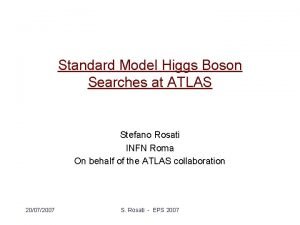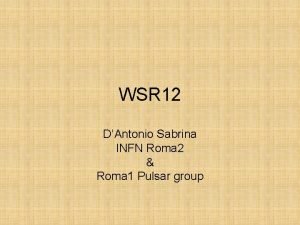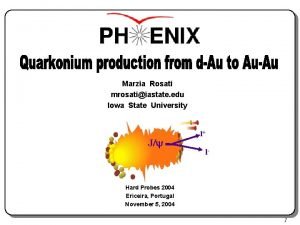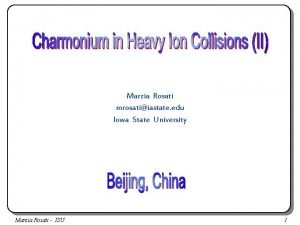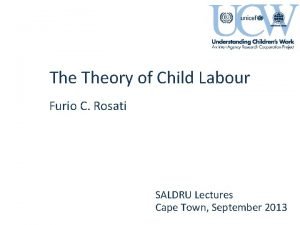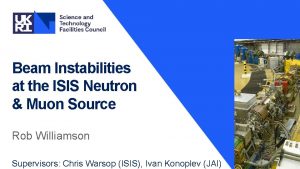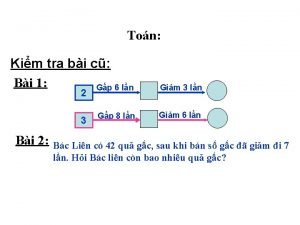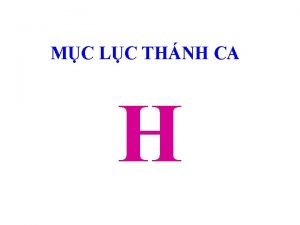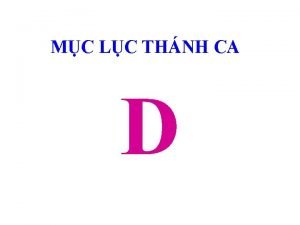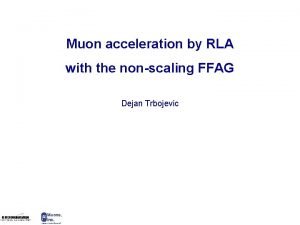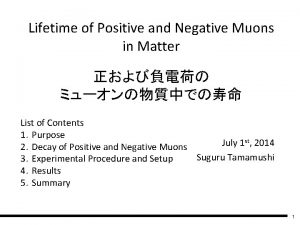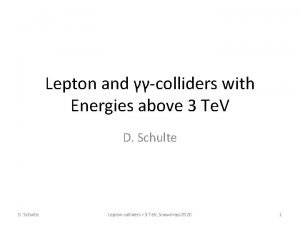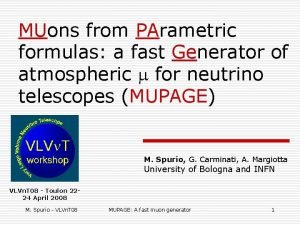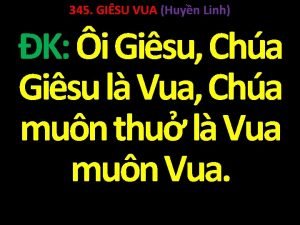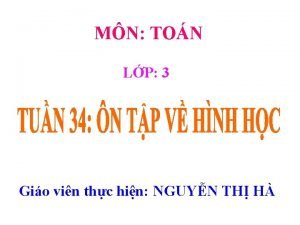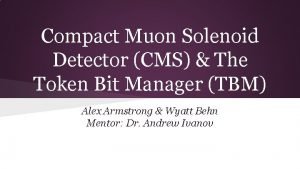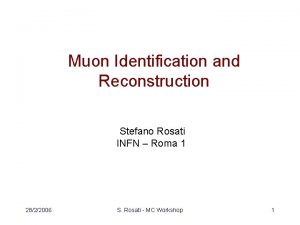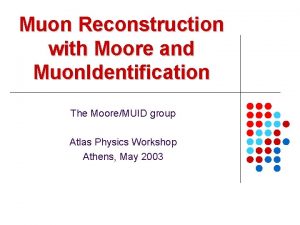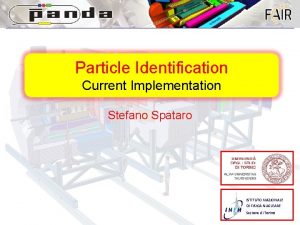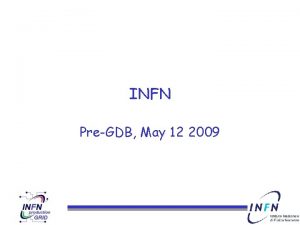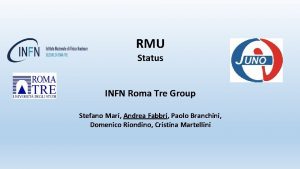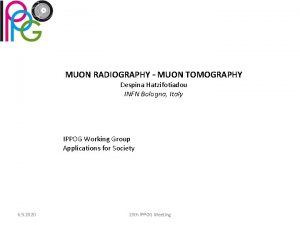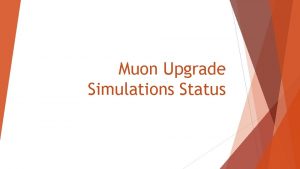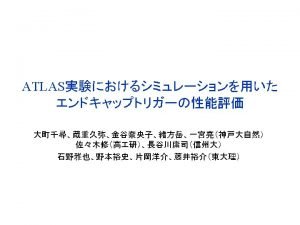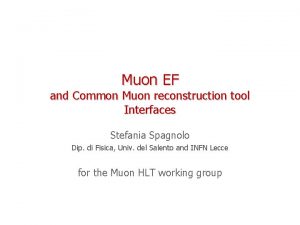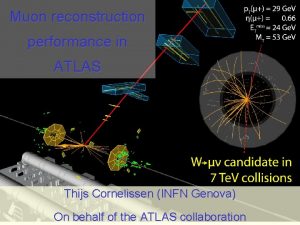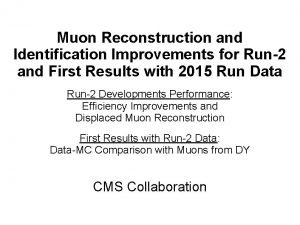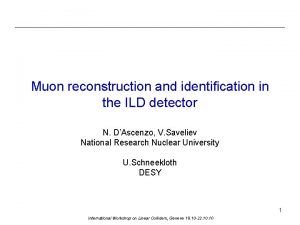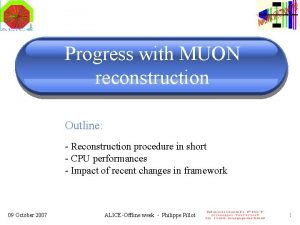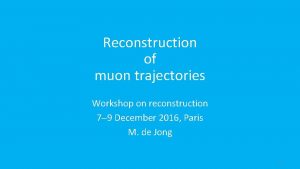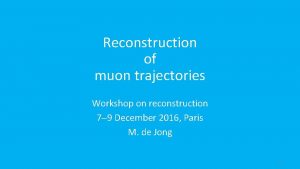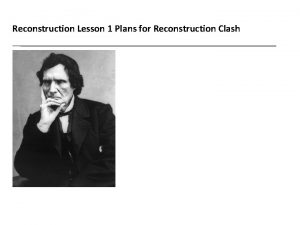Muon Identification and Reconstruction Stefano Rosati INFN Roma



























- Slides: 27

Muon Identification and Reconstruction Stefano Rosati INFN – Roma 1 28/2/2006 S. Rosati - MC Workshop 1

Muon Detectors for LHC Aspects of central relevance: • Trigger: reduce the event rate from the initial 40 MHz to the ~200 Hz affordable by the event storage system – Organized over more levels, the first one has to operate a fast (<10 ns) choice and identification of the Region of Interest – Following levels process a limited subset of data (only from the Ro. I) with higher resolution and detail – Final level very close to offline reconstruction, running online on Ro. I data. • Offline reconstruction: provide optimal muon identification and momentum resolution over the p. T range 5 -1000 Ge. V – Standalone reconstruction can exploit the cleaner environment of the muon system – Combination with inner tracking detectors to improve resolution 28/2/2006 S. Rosati - MC Workshop 2

ATLAS and CMS Experiements Two approaches for the two experiments: • ATLAS: – 3 Air-core Toroids (one barrel, two endcaps), mean field 0. 6 T with excellent standalone capabilities – complemented by a 2 T Central Solenoid) – Different bending planes for Inner Detector and Muon Spectrometer (f and h) – Stringent requirements on tracking detectors resolution, calibration and alignment – Combined reconstruction gives optimal resolution in a certain momentum range • CMS: – – Muon Detectors in the return yoke of the 4 T inner solenoidal field Resolution dominated by Multiple Scattering up to ~200 Ge. V p. T Combined reconstruction needed to achieve optimal resolution Less stringent requirements on muon tracking detectors resolution, and on their calibration and alignment 28/2/2006 S. Rosati - MC Workshop 3

ATLAS Muon Trigger – LVL 1 Barrel Trigger • Uses dedicated detector system based on RPCs and TGCs • Selection of events with muons above a given p. T threshold (up to six programmable thresholds) • Coincidence of hits in space (both h and f) and time within geometrical windows in different trigger detector layers 28/2/2006 S. Rosati - MC Workshop 4

ATLAS – Level 1 Trigger • Endcap Efficiency vs p. T Threshold – acceptance up to |h|<2. 4 • Example trigger menus and final rates, after also LVL 2 and Event Filter (for L=2 • 1033 cm-2 s-1): 1 m 20 Ge. V, 2 m 10 Ge. V (40 Hz) 2 m 6 Ge. V (25 Hz) • Valid for both Barrel and Endcap 28/2/2006 S. Rosati - MC Workshop 5

Muon Reconstruction in ATLAS 3 points Initial layout angle-angle B~0 angle-point B B sometimes angle-angle Ribs 28/2/2006 S. Rosati - MC Workshop 6

ATLAS - Combined Reconstruction • Tracks are back-extrapolated to the IP Combined reco efficiency • Parameters corrected for energy losses and multiple scattering • Energy loss ~3 Ge. V at h=0 • Look for match with tracks reconstructed in the ID • Combined refit of the two tracks • or: statistical combination of track parameters • Inner Detector in a Solenoidal Field of 2 T. 28/2/2006 Initial layout Detector acceptance S. Rosati - MC Workshop 7

ATLAS – p. T Resolution • m-Spectrometer Standalone: ~10%*p. T 2 to 3% (p. T in Te. V) Resolution vs p. T 150 X 0 Calo Material: non-gaussian tails when back-extrapolated • Inner Detector Standalone: ~40%*p. T 1. 5 % (|h|<1. 9) ~200%*p. T 3% (|h|=2. 5) (p. T in Te. V) • Combination dominated by the Inner Detector below the cross-over point ~40 to 80 Ge. V (20 Ge. V in forward region) 28/2/2006 S. Rosati - MC Workshop 8

ATLAS – p. T Resolution • Muon Standalone reconstruction in brief: Contributions to the standalone resolution - 10% resolution up to 1 Te. V requires 50 mm sagitta resolution - Single point resolution ~80 mm (MDT tracker – r-t calibration needed) - ~25 measurement points over the 3 stations • Alignment and calibration contribution becomes relevant above ~200 Ge. V • Alignment through optical system + alignment with tracks (e. g. data with field off/on) required ~20 mm alignment precision obtained during TB of a full-scale slice 28/2/2006 S. Rosati - MC Workshop 9

Low p. T Muon Reconstruction • Low p. T muons (p. T 5 Ge. V) do not reach the outer muon stations • Extrapolate ID tracks and match with patterns of hits in the muon chambers Efficiency s=40 Me. V p. T (Me. V) 28/2/2006 S. Rosati - MC Workshop 10

ATLAS - Muon Isolation Calorimeter Isolation - transverse energy ID Isolation, Sp. T H ZZ* 4 l Zbb tt Ge. V ID vs Calo isolation 28/2/2006 • Isolation energies in a DR = 0. 2 cone • Correlation between Inner Detector and Calo isolation Ge. V- MC Workshop S. Rosati 11

ATLAS - Muon Isolation • Mean value of the transverse EM energy vs cone size • Low and High Luminosity Pileup 28/2/2006 S. Rosati - MC Workshop 12

Impact Parameter Example: • d 0 significance in H ZZ* 4 l event selection • Reject Zbb and tt backgrounds • d 0 w. r. t. primary interaction vertex fitted s=13 mm Signal Zbb tt Highest significance 28/2/2006 S. Rosati - MC Workshop 2 nd Highest 13

ATLAS - Cavern Background • High background level expected in the ATLAS experimental hall • Background particles originating from p+p hadrons + interactions in: • ATLAS shielding, forward detectors, machine elements • Relevant for trigger (fake coincidences), reconstruction (pattern recognition), detectors ageing (~0. 7 C/cm after 10 years LHC on MDT wires) Cavern background composition neutrons 53. 94% photons 43. 15% electrons 1. 88% protons 0. 54% positrons 0. 21% anti-neutrons 0. 17% muons (+-) 0. 06% 28/2/2006 S. Rosati - MC Workshop Rates 14

Cavern Background • Tracking detectors sensitivities to neutral particles - photons ~1% - neutrons ~0. 1% Energy distribution • Safety factors included in simulations to account for model uncertainties • High rates of uncorrelated hits: e. g. at L=1034 cm-2 s-1, safety factor 5, 30 K hits in MDT chambers (~10% occupancy) • Forward processes critical for the correct estimation of background production • Propagation of low-energy g and n 28/2/2006 10 ke. V S. Rosati - MC Workshop 15

ATLAS - Performance • Mass resolutions for benchmark physics processes • Z mm fundamental to determine the detector mass scale with the first data, MS and MS-ID data H ZZ* 4 m (M=130 Ge. V) s=1. 9 Ge. V 28/2/2006 Muon Combined S. Rosati - MC Workshop Z mm Muon Standalone s=3. 0 Ge. V Z mm Muon Combined s=2. 5 Ge. V 16

CMS Muon System • 4 measurement stations interleaved with the iron yoke slabs • 4 T field in the Solenoid • Drift Tubes and RPC in the Barrel • CSC and RPC in endcap, RPC coverage up to |h|=1. 6 28/2/2006 S. Rosati - MC Workshop 17

CMS LVL 1 Trigger • Two independent and redundant systems DT+CSC or RPC, can be combined, together with calorimeters in a global trigger (GMT) • Trigger coverage for single muons up to |h|=2. 1 • RPC Trigger will cover up to |h|=1. 6 at the startup 28/2/2006 S. Rosati - MC Workshop 18

CMS Muon Reconstruction • Tracks are reconstructed in the muon spectrometer and back-extrapolated to the inner silicon tracker • GEANE package for the propagation through calo and coil material • Combined refit with vertex constraint 28/2/2006 S. Rosati - MC Workshop 19

CMS Muon Identification • Muon Compatibility Values for two algs: • matching tracks with deposits in outer hadron calo • matching tracks with patterns in the inner muon chambers, not used for a standalone track fit • Cuts on discriminating values tunable for efficiency/purity Calorimeter Match 28/2/2006 Muon Detectors Match S. Rosati - MC Workshop 20

CMS Muon Identification • Reconstruction+identification efficiency for muons in b-jets (p. T>5 Ge. V) Outside-in approach Inside-out approach (track in Inner Detector matched with muon hits) 28/2/2006 S. Rosati - MC Workshop 21

CMS - p. T Resolution • s(q/p. T) for various momenta Standalone reconstruction 28/2/2006 Combined reconstruction S. Rosati - MC Workshop 22

CMS p. T Resolution • Dp/p resolution in barrel and endcap 28/2/2006 S. Rosati - MC Workshop 23

CMS Muon Isolation • b-jet muon rejection vs efficiency for W mn identification • Three independent isolation criteria: - Energy deposits in calorimeters - Hits in pixel detector - Tracks reconstructed in inner tracker 28/2/2006 S. Rosati - MC Workshop 24

CMS - Performance 28/2/2006 S. Rosati - MC Workshop 25

CMS - Performance • Z mm , reconstructed mass - 1 day of data taking at L=2 • 1033 cm-2 s-1 - QCD background and pileup included • Z’(1 Te. V) mm in three scenarios: - Ideal geometry - First data misalignment - Long term misalignment • Alignment exploiting inclusive single muons with p. T>40 Ge. V and Z mm 28/2/2006 S. Rosati - MC Workshop 26

In conclusione: competenze italiane • ATLAS-Muon (Bologna, Cosenza, Frascati, Lecce, Napoli, Pavia, Roma 1, Roma 2, Roma 3) – – Trigger (Livello 1 barrel, Livello 2, Event Filter) Calibrazione ed allineamento MDT Simulazione del rivelatore, studi sul fondo di caverna Ricostruzione standalone e combinata, online e offline, Analysis Software Framework – Analisi (Z+jets, H ZZ* 4 l, A/h mm, Susy searches ) • CMS-Muon (Bari, Bologna, Napoli, Padova, Torino) – – Trigger di Livello 1 con I DT Simulazione/digitizzazione, trigger RPC Ricostruzione, High Level Trigger, Analysis Software Framework Analisi (H WW 2 m 2 n, H ZZ 2 e 2 m, h mm, WW scattering) • Grazie a Ugo Gasparini per tutta la documentazione su CMS 28/2/2006 S. Rosati - MC Workshop 27
 Performance assessment
Performance assessment Infn roma tor vergata
Infn roma tor vergata Infn roma 2
Infn roma 2 Marzia rosati
Marzia rosati Carol rosati
Carol rosati Marzia rosati
Marzia rosati Ron rosati
Ron rosati Fred rosati
Fred rosati Central pocket whorl vs plain whorl
Central pocket whorl vs plain whorl Isis neutron and muon source
Isis neutron and muon source Muôốn tìm số chia
Muôốn tìm số chia đến muôn đời con cảm tạ ơn chúa
đến muôn đời con cảm tạ ơn chúa Vì chúa yêu tôi nên tôi theo gót ngài
Vì chúa yêu tôi nên tôi theo gót ngài Con xin dâng lên muôn lời suy tôn
Con xin dâng lên muôn lời suy tôn Muon collider
Muon collider Positive muon
Positive muon Muon collider
Muon collider Ca vang lên nào
Ca vang lên nào Muốn xoá một hoặc nhiều cột em thực hiện: *
Muốn xoá một hoặc nhiều cột em thực hiện: * Muôn thiên thần cánh trắng
Muôn thiên thần cánh trắng Cocine
Cocine Mênh mông muôn mẫu một màu mưa
Mênh mông muôn mẫu một màu mưa Xin giấu con nơi cánh tay cha
Xin giấu con nơi cánh tay cha Gisu
Gisu Muốn tính chu vi hình chữ nhật
Muốn tính chu vi hình chữ nhật Mn ton
Mn ton Núi muôn đời vững chãi
Núi muôn đời vững chãi Solend token
Solend token
